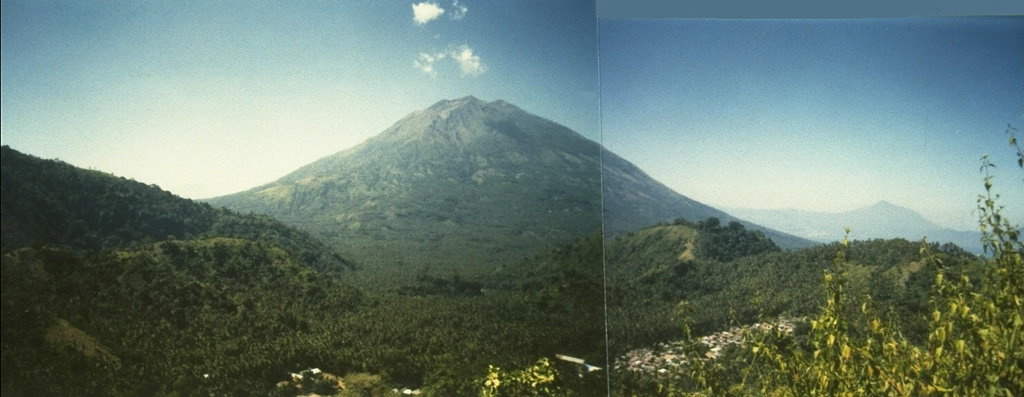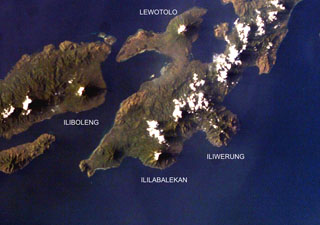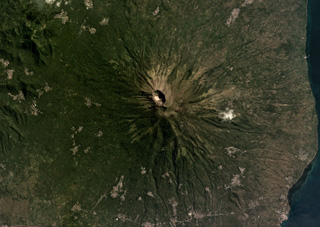

Small ash eruptions
Ash eruptions occurred on 3 and 15 November 1991, ejecting columns to a maximum of ~150 m above the crater rim. Since then, an average of 47 shallow earthquakes have been recorded monthly, and a white vapor column continued to rise to ~ 50 m above the crater.
Information Contacts: W. Modjo and W. Tjetjep, VSI.
The Global Volcanism Program has no Weekly Reports available for Iliboleng.
Reports are organized chronologically and indexed below by Month/Year (Publication Volume:Number), and include a one-line summary. Click on the index link or scroll down to read the reports.
Small ash eruption
VSI reported that an ash eruption began on 17 November at 0615. The ash column rose ~ 1 km and was blown N, causing thin ashfalls on nearby villages. The eruption ended after several hours. As of mid-Jan, no additional activity had been reported. Press sources noted that the eruption was preceded by a moderately strong, felt earthquake on 15 November at about 2300.
Information Contacts: A. Sudradjat and O. Mandraguna, VSI; M. Krafft, Cernay; SinarHarapan, Jakarta.
Small plume photographed by Space Shuttle astronauts
[Photographs taken on 31 August (figure 1) and] 4 September by astronauts on Space Shuttle mission STS-8 showed small, relatively diffuse plumes long emerging from Iliboleng. [The 31 August plume extended at least 40 km and the 4 September plume was roughly 50-70 km long.]
Information Contacts: C. Wood and R. Underwood, NASA, Houston.
Explosion; grassfires from ashfall; 570 evacuated
Iliboleng erupted on 28 May at 1735. A single explosion ejected incandescent material and caused ashfall on a nearby plantation and several villages both E and W of the summit (Lamalota, Dua Muda, Tuawolo, and Kiwangona). The incandescent ashfalls caused grass fires in the very dry area (no rain reported since February) that burned 700 hectares of grass W of the volcano and 250 hectares to the E. About 570 people were evacuated from several villages after the initial explosion and grass fires, but returned to their homes 31 May.
On 2 June at 0500, weather had cleared and a white vapor cloud of ~100 m height was reported. B-type earthquakes were recorded in the area on 21 May, but no more seismic data were available.
Information Contacts: A. Sudradjat, L. Pardyanto, and T. Casadevall, VSI.
800-m eruption cloud
Iliboleng erupted on 18 July at 1234, ejecting a cloud to ~ 800 m above the summit.
Information Contacts: L. Pardyanto, Olas, Kaswanda, Suratman, A. Sudradjat, and T. Casadevall, VSI.
Renewed explosions after 12 days of seismicity
Explosions occurred 10, 15, and 24 November. A gas and ash column emitted on 24 November at 0712 reached 1,000 m height and was blown NNW, covering 18.7 km2 with ~1 mm of ash. There were no casualties. Shallow volcanic seismicity began 30 October, with as many as 60 events/day. Eruption tremor was recorded for 1.5 minutes on 10 November.
Information Contacts: VSI; ANS.
Earthquakes increase; 300-m-high plume
Since 20 June, a plume has risen as much as 300 m above the summit. The number of shallow volcanic earthquakes increased to ~20/day 20-25 June, compared to 1/day previously. No eruptive activity has been reported since November.
Information Contacts: VSI.
Volcanic earthquakes decline late in month
During July, white plumes continued to be emitted to 300 m above the peak. Several shallow volcanic earthquakes were recorded daily during early July. In late July, seismic activity had returned to low background levels.
Information Contacts: VSI.
Explosion deposits ash on nearby village
A large explosion occurred on 2 October at 2252, depositing a light dusting of ash on villages near the volcano.
Information Contacts: VSI.
Continued seismicity follows explosion
A large explosion on 2 October at 2252 deposited a light dusting of ash in about a 15 km2 area around the volcano. During the week of 9-15 October, white fume was continuously present above the crater, rising to heights of 300 m. During that week, about 13 tectonic and 11 volcanic events were recorded/day.
Information Contacts: VSI.
Fumarolic emissions; felt earthquake
In July, fumarole temperatures in the crater were 60-70°C. On 15 July, an MM II earthquake was felt. The number and types of earthquakes recorded were: 131 distant tectonic, three local tectonic, two volcanic A-type, and 144 volcanic B-type. The volcano's level of activity is slightly higher than normal.
Information Contacts: VSI.
Vapor and ash emission
Vapor and ash were continuously emitted to 100-850 m height, beginning 8 May and continuing through June. Shallow volcanic earthquakes were recorded 15-25 times/week (figure 2), but no explosion earthquakes were recorded. Tectonic earthquakes averaged 14-24/week.
Information Contacts: W. Modjo, VSI.
Small ash eruptions
Ash eruptions occurred on 3 and 15 November 1991, ejecting columns to a maximum of ~150 m above the crater rim. Since then, an average of 47 shallow earthquakes have been recorded monthly, and a white vapor column continued to rise to ~ 50 m above the crater.
Information Contacts: W. Modjo and W. Tjetjep, VSI.
This compilation of synonyms and subsidiary features may not be comprehensive. Features are organized into four major categories: Cones, Craters, Domes, and Thermal Features. Synonyms of features appear indented below the primary name. In some cases additional feature type, elevation, or location details are provided.
Synonyms |
||||
| Bolin | Wakka | Lamatelang | ||||
Cones |
||||
| Feature Name | Feature Type | Elevation | Latitude | Longitude |
| Balile | Cone | 262 m | ||
|
|
||||||||||||||||||||||||||
There is data available for 20 confirmed Holocene eruptive periods.
1993 Jun 16 (?) ± 15 days - 1993 Jul 16 ± 15 days Confirmed Eruption VEI: 1 (?)
| Episode 1 | Eruption | ||||||||||||||||||||||||||||||||||||||||
|---|---|---|---|---|---|---|---|---|---|---|---|---|---|---|---|---|---|---|---|---|---|---|---|---|---|---|---|---|---|---|---|---|---|---|---|---|---|---|---|---|
| 1993 Jun 16 (?) ± 15 days - 1993 Jul 16 ± 15 days | Evidence from Observations: Reported | |||||||||||||||||||||||||||||||||||||||
|
List of 6 Events for Episode 1
| ||||||||||||||||||||||||||||||||||||||||
1991 Nov 3 - 1991 Nov 15 Confirmed Eruption VEI: 1
| Episode 1 | Eruption | |||||||||||||||||||||||||
|---|---|---|---|---|---|---|---|---|---|---|---|---|---|---|---|---|---|---|---|---|---|---|---|---|---|
| 1991 Nov 3 - 1991 Nov 15 | Evidence from Observations: Reported | ||||||||||||||||||||||||
|
List of 3 Events for Episode 1
| |||||||||||||||||||||||||
1991 May 8 - 1991 Jun 30 (in or after) Confirmed Eruption VEI: 1
| Episode 1 | Eruption | ||||||||||||||||||||||||||||||
|---|---|---|---|---|---|---|---|---|---|---|---|---|---|---|---|---|---|---|---|---|---|---|---|---|---|---|---|---|---|---|
| 1991 May 8 - 1991 Jun 30 (in or after) | Evidence from Observations: Reported | |||||||||||||||||||||||||||||
|
List of 4 Events for Episode 1
| ||||||||||||||||||||||||||||||
1987 Oct 2 - 1987 Oct 2 Confirmed Eruption VEI: 2
| Episode 1 | Eruption | |||||||||||||||||||||||||||||||||||
|---|---|---|---|---|---|---|---|---|---|---|---|---|---|---|---|---|---|---|---|---|---|---|---|---|---|---|---|---|---|---|---|---|---|---|---|
| 1987 Oct 2 - 1987 Oct 2 | Evidence from Observations: Reported | ||||||||||||||||||||||||||||||||||
|
List of 5 Events for Episode 1
| |||||||||||||||||||||||||||||||||||
1986 May 28 - 1986 Nov 24 Confirmed Eruption VEI: 1
| Episode 1 | Eruption | ||||||||||||||||||||||||||||||||||||||||
|---|---|---|---|---|---|---|---|---|---|---|---|---|---|---|---|---|---|---|---|---|---|---|---|---|---|---|---|---|---|---|---|---|---|---|---|---|---|---|---|---|
| 1986 May 28 - 1986 Nov 24 | Evidence from Observations: Reported | |||||||||||||||||||||||||||||||||||||||
|
List of 6 Events for Episode 1
| ||||||||||||||||||||||||||||||||||||||||
1983 May 11 - 1984 Apr 13 Confirmed Eruption VEI: 2
| Episode 1 | Eruption | ||||||||||||||||||||||||||||||
|---|---|---|---|---|---|---|---|---|---|---|---|---|---|---|---|---|---|---|---|---|---|---|---|---|---|---|---|---|---|---|
| 1983 May 11 - 1984 Apr 13 | Evidence from Observations: Reported | |||||||||||||||||||||||||||||
|
List of 4 Events for Episode 1
| ||||||||||||||||||||||||||||||
1982 Nov 17 - 1982 Nov 17 Confirmed Eruption VEI: 2
| Episode 1 | Eruption | ||||||||||||||||||||||||||||||
|---|---|---|---|---|---|---|---|---|---|---|---|---|---|---|---|---|---|---|---|---|---|---|---|---|---|---|---|---|---|---|
| 1982 Nov 17 - 1982 Nov 17 | Evidence from Observations: Reported | |||||||||||||||||||||||||||||
|
List of 4 Events for Episode 1
| ||||||||||||||||||||||||||||||
1973 Apr 16 ± 15 days - 1974 Apr 16 ± 15 days Confirmed Eruption VEI: 2
| Episode 1 | Eruption | |||||||||||||||||||||||||||||||||||
|---|---|---|---|---|---|---|---|---|---|---|---|---|---|---|---|---|---|---|---|---|---|---|---|---|---|---|---|---|---|---|---|---|---|---|---|
| 1973 Apr 16 ± 15 days - 1974 Apr 16 ± 15 days | Evidence from Observations: Reported | ||||||||||||||||||||||||||||||||||
|
List of 5 Events for Episode 1
| |||||||||||||||||||||||||||||||||||
1951 Jul 2 ± 182 days Confirmed Eruption VEI: 2 (?)
| Episode 1 | Eruption | ||||||||||||||||||||
|---|---|---|---|---|---|---|---|---|---|---|---|---|---|---|---|---|---|---|---|---|
| 1951 Jul 2 ± 182 days - Unknown | Evidence from Observations: Reported | |||||||||||||||||||
|
List of 2 Events for Episode 1
| ||||||||||||||||||||
1950 Mar 16 ± 15 days - 1950 Aug 16 (?) ± 15 days Confirmed Eruption VEI: 2
| Episode 1 | Eruption | ||||||||||||||||||||
|---|---|---|---|---|---|---|---|---|---|---|---|---|---|---|---|---|---|---|---|---|
| 1950 Mar 16 ± 15 days - 1950 Aug 16 (?) ± 15 days | Evidence from Observations: Reported | |||||||||||||||||||
|
List of 2 Events for Episode 1
| ||||||||||||||||||||
1949 Jun 12 Confirmed Eruption VEI: 2
| Episode 1 | Eruption | ||||||||||||||||||||
|---|---|---|---|---|---|---|---|---|---|---|---|---|---|---|---|---|---|---|---|---|
| 1949 Jun 12 - Unknown | Evidence from Observations: Reported | |||||||||||||||||||
|
List of 2 Events for Episode 1
| ||||||||||||||||||||
1949 Feb 4 Confirmed Eruption VEI: 2
| Episode 1 | Eruption | ||||||||||||||||||||
|---|---|---|---|---|---|---|---|---|---|---|---|---|---|---|---|---|---|---|---|---|
| 1949 Feb 4 - Unknown | Evidence from Observations: Reported | |||||||||||||||||||
|
List of 2 Events for Episode 1
| ||||||||||||||||||||
1948 Apr 29 Confirmed Eruption VEI: 2
| Episode 1 | Eruption | |||||||||||||||||||||||||
|---|---|---|---|---|---|---|---|---|---|---|---|---|---|---|---|---|---|---|---|---|---|---|---|---|---|
| 1948 Apr 29 - Unknown | Evidence from Observations: Reported | ||||||||||||||||||||||||
|
List of 3 Events for Episode 1
| |||||||||||||||||||||||||
1944 Aug - 1944 Oct Confirmed Eruption VEI: 2
| Episode 1 | Eruption | |||||||||||||||||||||||||
|---|---|---|---|---|---|---|---|---|---|---|---|---|---|---|---|---|---|---|---|---|---|---|---|---|---|
| 1944 Aug - 1944 Oct | Evidence from Observations: Reported | ||||||||||||||||||||||||
|
List of 3 Events for Episode 1
| |||||||||||||||||||||||||
1927 Confirmed Eruption VEI: 2
| Episode 1 | Eruption | ||||||||||||||||||||
|---|---|---|---|---|---|---|---|---|---|---|---|---|---|---|---|---|---|---|---|---|
| 1927 - Unknown | Evidence from Observations: Reported | |||||||||||||||||||
|
List of 2 Events for Episode 1
| ||||||||||||||||||||
1925 Confirmed Eruption VEI: 2
| Episode 1 | Eruption | |||||||||||||||||||||||||
|---|---|---|---|---|---|---|---|---|---|---|---|---|---|---|---|---|---|---|---|---|---|---|---|---|---|
| 1925 - Unknown | Evidence from Observations: Reported | ||||||||||||||||||||||||
|
List of 3 Events for Episode 1
| |||||||||||||||||||||||||
1909 Nov 9 Confirmed Eruption VEI: 2
| Episode 1 | Eruption | ||||||||||||||||||||
|---|---|---|---|---|---|---|---|---|---|---|---|---|---|---|---|---|---|---|---|---|
| 1909 Nov 9 - Unknown | Evidence from Observations: Reported | |||||||||||||||||||
|
List of 2 Events for Episode 1
| ||||||||||||||||||||
1904 Confirmed Eruption VEI: 2
| Episode 1 | Eruption | ||||||||||||||||||||||||||||||
|---|---|---|---|---|---|---|---|---|---|---|---|---|---|---|---|---|---|---|---|---|---|---|---|---|---|---|---|---|---|---|
| 1904 - Unknown | Evidence from Observations: Reported | |||||||||||||||||||||||||||||
|
List of 4 Events for Episode 1
| ||||||||||||||||||||||||||||||
1888 Confirmed Eruption VEI: 2
| Episode 1 | Eruption | ||||||||||||||||||||||||||||||
|---|---|---|---|---|---|---|---|---|---|---|---|---|---|---|---|---|---|---|---|---|---|---|---|---|---|---|---|---|---|---|
| 1888 - Unknown | Evidence from Observations: Reported | |||||||||||||||||||||||||||||
|
List of 4 Events for Episode 1
| ||||||||||||||||||||||||||||||
1885 Sep - 1885 Oct Confirmed Eruption VEI: 2
| Episode 1 | Eruption | ||||||||||||||||||||
|---|---|---|---|---|---|---|---|---|---|---|---|---|---|---|---|---|---|---|---|---|
| 1885 Sep - 1885 Oct | Evidence from Observations: Reported | |||||||||||||||||||
|
List of 2 Events for Episode 1
| ||||||||||||||||||||
There is no Deformation History data available for Iliboleng.
There is no Emissions History data available for Iliboleng.
 Iliboleng volcano at the SE end of Adonara Island, east of Flores Island, is a symmetrical stratovolcano with many partially overlapping summit craters. Iliboleng is seen here from Bukit Tomu, north of the volcano. Explosive eruptions from the summit crater have been recorded since 1885. Only one historical eruption, in 1888, produced a lava flow.
Iliboleng volcano at the SE end of Adonara Island, east of Flores Island, is a symmetrical stratovolcano with many partially overlapping summit craters. Iliboleng is seen here from Bukit Tomu, north of the volcano. Explosive eruptions from the summit crater have been recorded since 1885. Only one historical eruption, in 1888, produced a lava flow. Iliboleng volcano rises above the Boleng strait between Adonara and Lomblen Islands, at the eastern end of the Lesser Sunda (Nusa Tenggara) Islands. The symmetrical volcano, which occupies the SE corner of Adonara, is seen here from the NE tip of the island. The 1659-m-high stratovolcano, the only historically active volcano on the island, is one of the most active in the Lesser Sundas.
Iliboleng volcano rises above the Boleng strait between Adonara and Lomblen Islands, at the eastern end of the Lesser Sunda (Nusa Tenggara) Islands. The symmetrical volcano, which occupies the SE corner of Adonara, is seen here from the NE tip of the island. The 1659-m-high stratovolcano, the only historically active volcano on the island, is one of the most active in the Lesser Sundas. Four volcanoes are seen in this NASA International Space Station image (with north to the upper left) of Solor (lower left), Adonara (upper left), and Lembata (right) Islands. Ililabalekan volcano on SW Lembata (formerly Lomblen) Island is the only one of these without historical eruptions, although fumaroles are found near its summit. A satellitic cone was constructed on the SE flank of the steep-sided volcano, and four craters, one of which contains a lava dome and two small explosion pits, occur at the summit of Mount Labalekan.
Four volcanoes are seen in this NASA International Space Station image (with north to the upper left) of Solor (lower left), Adonara (upper left), and Lembata (right) Islands. Ililabalekan volcano on SW Lembata (formerly Lomblen) Island is the only one of these without historical eruptions, although fumaroles are found near its summit. A satellitic cone was constructed on the SE flank of the steep-sided volcano, and four craters, one of which contains a lava dome and two small explosion pits, occur at the summit of Mount Labalekan. An eruption at Iliboleng began on 11 May 1983 when an ash plume rose to 500 m. Ash and incandescent ejecta was reported on 13 July and fine ash occasionally fell from the plume on 15 July. On 4 September space shuttle astronauts photographed this small diffuse plume 50-70 km long, and an ash plume was reported again on 22 September. A 500 m ash plume was seen for a few minutes on 24 November, and additional plumes were emitted on 3 January and 13 April 1984 to a maximum height of 1 km.
An eruption at Iliboleng began on 11 May 1983 when an ash plume rose to 500 m. Ash and incandescent ejecta was reported on 13 July and fine ash occasionally fell from the plume on 15 July. On 4 September space shuttle astronauts photographed this small diffuse plume 50-70 km long, and an ash plume was reported again on 22 September. A 500 m ash plume was seen for a few minutes on 24 November, and additional plumes were emitted on 3 January and 13 April 1984 to a maximum height of 1 km. The summit craters of Iliboleng are near the center of this May 2019 Planet Labs satellite image monthly mosaic (N is at the top). The larger crater is approximately 500 x 700 m.
The summit craters of Iliboleng are near the center of this May 2019 Planet Labs satellite image monthly mosaic (N is at the top). The larger crater is approximately 500 x 700 m.Maps are not currently available due to technical issues.
There are no samples for Iliboleng in the Smithsonian's NMNH Department of Mineral Sciences Rock and Ore collection.
| Copernicus Browser | The Copernicus Browser replaced the Sentinel Hub Playground browser in 2023, to provide access to Earth observation archives from the Copernicus Data Space Ecosystem, the main distribution platform for data from the EU Copernicus missions. |
| MIROVA | Middle InfraRed Observation of Volcanic Activity (MIROVA) is a near real time volcanic hot-spot detection system based on the analysis of MODIS (Moderate Resolution Imaging Spectroradiometer) data. In particular, MIROVA uses the Middle InfraRed Radiation (MIR), measured over target volcanoes, in order to detect, locate and measure the heat radiation sourced from volcanic activity. |
| MODVOLC Thermal Alerts | Using infrared satellite Moderate Resolution Imaging Spectroradiometer (MODIS) data, scientists at the Hawai'i Institute of Geophysics and Planetology, University of Hawai'i, developed an automated system called MODVOLC to map thermal hot-spots in near real time. For each MODIS image, the algorithm automatically scans each 1 km pixel within it to check for high-temperature hot-spots. When one is found the date, time, location, and intensity are recorded. MODIS looks at every square km of the Earth every 48 hours, once during the day and once during the night, and the presence of two MODIS sensors in space allows at least four hot-spot observations every two days. Each day updated global maps are compiled to display the locations of all hot spots detected in the previous 24 hours. There is a drop-down list with volcano names which allow users to 'zoom-in' and examine the distribution of hot-spots at a variety of spatial scales. |
|
WOVOdat
Single Volcano View Temporal Evolution of Unrest Side by Side Volcanoes |
WOVOdat is a database of volcanic unrest; instrumentally and visually recorded changes in seismicity, ground deformation, gas emission, and other parameters from their normal baselines. It is sponsored by the World Organization of Volcano Observatories (WOVO) and presently hosted at the Earth Observatory of Singapore.
GVMID Data on Volcano Monitoring Infrastructure The Global Volcano Monitoring Infrastructure Database GVMID, is aimed at documenting and improving capabilities of volcano monitoring from the ground and space. GVMID should provide a snapshot and baseline view of the techniques and instrumentation that are in place at various volcanoes, which can be use by volcano observatories as reference to setup new monitoring system or improving networks at a specific volcano. These data will allow identification of what monitoring gaps exist, which can be then targeted by remote sensing infrastructure and future instrument deployments. |
| Volcanic Hazard Maps | The IAVCEI Commission on Volcanic Hazards and Risk has a Volcanic Hazard Maps database designed to serve as a resource for hazard mappers (or other interested parties) to explore how common issues in hazard map development have been addressed at different volcanoes, in different countries, for different hazards, and for different intended audiences. In addition to the comprehensive, searchable Volcanic Hazard Maps Database, this website contains information about diversity of volcanic hazard maps, illustrated using examples from the database. This site is for educational purposes related to volcanic hazard maps. Hazard maps found on this website should not be used for emergency purposes. For the most recent, official hazard map for a particular volcano, please seek out the proper institutional authorities on the matter. |
| IRIS seismic stations/networks | Incorporated Research Institutions for Seismology (IRIS) Data Services map showing the location of seismic stations from all available networks (permanent or temporary) within a radius of 0.18° (about 20 km at mid-latitudes) from the given location of Iliboleng. Users can customize a variety of filters and options in the left panel. Note that if there are no stations are known the map will default to show the entire world with a "No data matched request" error notice. |
| UNAVCO GPS/GNSS stations | Geodetic Data Services map from UNAVCO showing the location of GPS/GNSS stations from all available networks (permanent or temporary) within a radius of 20 km from the given location of Iliboleng. Users can customize the data search based on station or network names, location, and time window. Requires Adobe Flash Player. |
| DECADE Data | The DECADE portal, still in the developmental stage, serves as an example of the proposed interoperability between The Smithsonian Institution's Global Volcanism Program, the Mapping Gas Emissions (MaGa) Database, and the EarthChem Geochemical Portal. The Deep Earth Carbon Degassing (DECADE) initiative seeks to use new and established technologies to determine accurate global fluxes of volcanic CO2 to the atmosphere, but installing CO2 monitoring networks on 20 of the world's 150 most actively degassing volcanoes. The group uses related laboratory-based studies (direct gas sampling and analysis, melt inclusions) to provide new data for direct degassing of deep earth carbon to the atmosphere. |
| Large Eruptions of Iliboleng | Information about large Quaternary eruptions (VEI >= 4) is cataloged in the Large Magnitude Explosive Volcanic Eruptions (LaMEVE) database of the Volcano Global Risk Identification and Analysis Project (VOGRIPA). |
| EarthChem | EarthChem develops and maintains databases, software, and services that support the preservation, discovery, access and analysis of geochemical data, and facilitate their integration with the broad array of other available earth science parameters. EarthChem is operated by a joint team of disciplinary scientists, data scientists, data managers and information technology developers who are part of the NSF-funded data facility Integrated Earth Data Applications (IEDA). IEDA is a collaborative effort of EarthChem and the Marine Geoscience Data System (MGDS). |